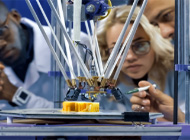
As technology advances, different 3D printing technologies have also emerged and introduced. Currently, the most used and popular technologies are SLS (Selective Laser Sintering), FDM (Fused Deposition Modelling), SLA (Stereolithography) and DLP (Digital Light Processing). These 3D printing technologies follow similar principles but produce significantly different outputs.
Understanding each 3D printing method helps user identify what they really need and what to expect from final 3D prints. They can also learn how to maximise the potential of each type of 3D printer.
To understand this topic more, below is the side by side comparison of the popular and most used 3D printing methods today.
Describing the process
- SLS vs FDM
SLS or Selective Laser Sintering is known to be the most common 3D printing technology that is used for industrial applications. Its main material is nylon/polyamide in powdered form. This is a process which uses high powered laser to fuse together small particles of the material.
FDM is a 3D printing method wherein layers of filament materials are melted and fused while it is positioned in a structured way to create an object.
- SLA vs DLP
Both SLA and DLP are technologies that create a 3D part by selectively curing polymer resin layer by layer. The only difference is the light source and how it is being used in the process.
SLA utilises UV laser beam to cure or harden the resin material. The laser beam also cures the material layer by layer, and in series of points. DLP, on the other hand uses projector to flash an image across the entire platform at once.
Printing cost
The overall cost is one of the factors when choosing what type of method is appropriate for your project. Here is the side by side comparison of its printing cost.
- SLS vs FDM
SLS is mainly used for industrial applications such as in aerospace, healthcare, electronics, etc. Because of that, SLS printers are usually large and can be very expensive.
Among all the printing technologies, FDM is the cheapest method. It is often used by individuals who do not have big budget to buy expensive printers and 3D printing materials.
- SLA vs DLP
Both SLA and DLP uses resin material to print 3D parts. Resin can be very expensive as it costs around $80 to $150 per litre. The difference on their printing costs will only depend on the printer and the manufacturer of the resin material.
Printing speed
There are many factors that influence the printing speed. These factors include part orientation and amount of material to be printed.
Other factors may also include the temperature of the print nozzle, filament thickness, the material to heat, the laser power for SLA, number of supports required for FDM, etc.
- SLS vs FDM
Lead times for SLS 3D printing are typically shorter compared to FDM. Printing speed for SLS may reach up to 48 mm/h while FDM can print up from 50 to 150 mm/h depending on the printer.
- SLA vs DLP
When it comes to printing speed, DLP has the advantage. Since the entire layer of a 3D part is exposed to light at once, the printing process is quicker compared to SLA.
Post-processing
After the 3D part is taken out from any printer, there are some finishing touches that need to be done on the 3D part. Post-processing is a stage where the 3D part undergoes a number of processes to enhance its appearance.
- SLS vs FDM
Post-processing for SLS is not as complicated as the other technologies. You just have to clean up the unused or unsintered powder which served as support during printing. This can be done manually or with the use of compressed air.
When it comes to FDM, post-processing can be difficult. Improper dissolving of support structure can damage your print or may leave holes on the surface. It also needs specialized equipment such as glass containers or ultrasonic bath.
- SLA vs DLP
Post-processing for SLA can be time-consuming. There are some processes wherein the 3D part is required to be disposed and stored in special containers.
Moreover, since DLP printers render images using rectangular voxels, there is also an effect of vertical voxel lines on the surface. Thus, post-processing is also required. The appearance of voxel lines requires sanding process.
When to use these methods
In order to choose the best 3D printing method that will suit your project, here is a guideline on when to use a specific 3D printing method.
SLS
- For more advanced industrial 3D printing projects
- For objects with complex designs
- Rapid and functional prototyping
- Low-volume production
FDM
- Rapid prototyping
- Building low-cost models
- Great for hobbyists and fabricators
- Projects where precision and surface finish isn’t crucial
SLA
- Printing many small intricate parts at once
- Detailed large prints
- Creating moulds for mass-production
DLP
- One-off small and very complicated parts
- Quickly printing large parts without much detail
Conclusion
Choosing what 3D printing method to be used will always depend on what you will need for your project and your intended budget. With this guide, it can be easier to decide whether FDM, SLS, SLA or DLP is suitable for you.
But if you are still confused about what 3D printing method to use, then you can ask for professional help. You can look for a 3D printing service provider to cater your 3D printing needs.








